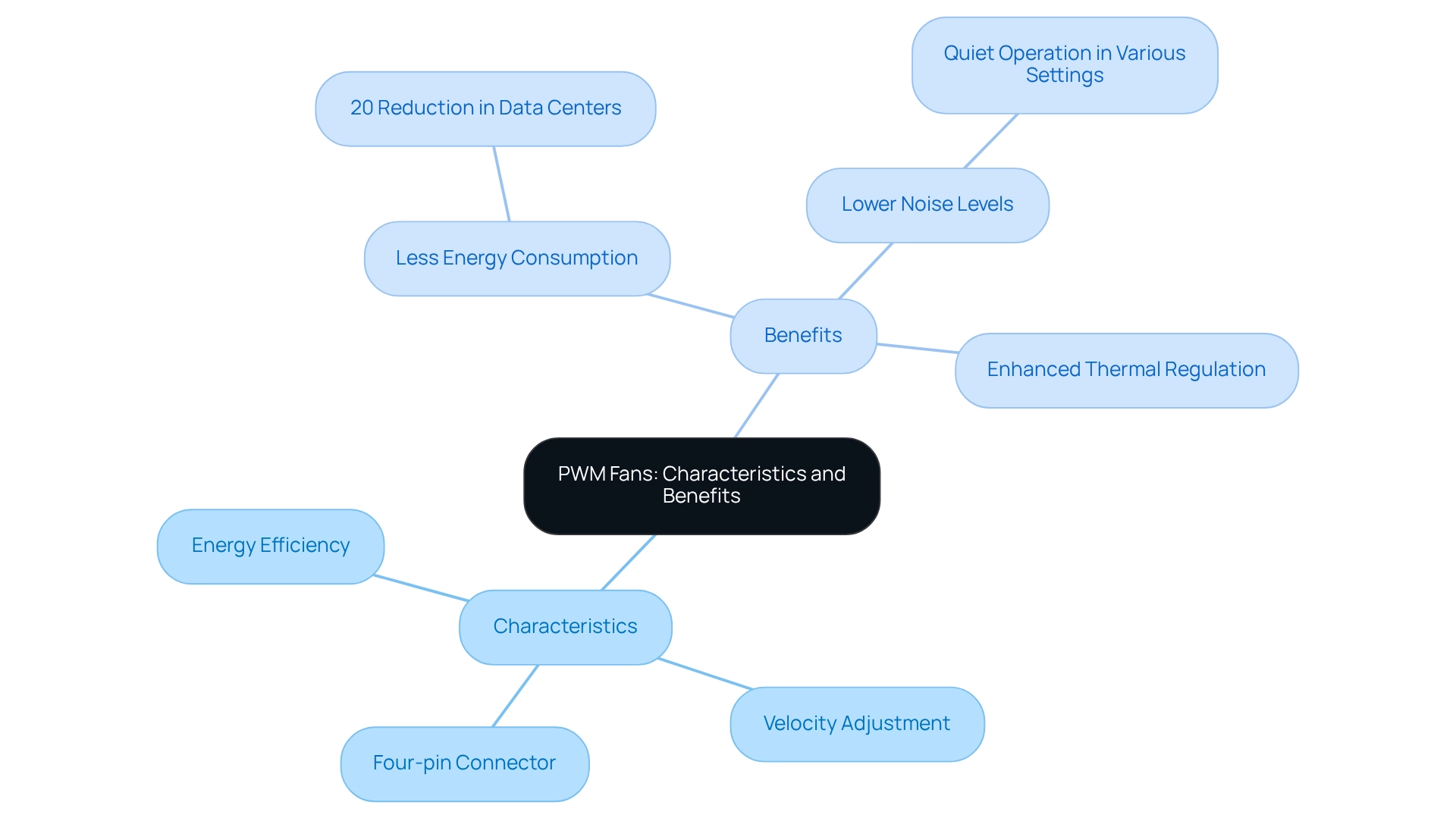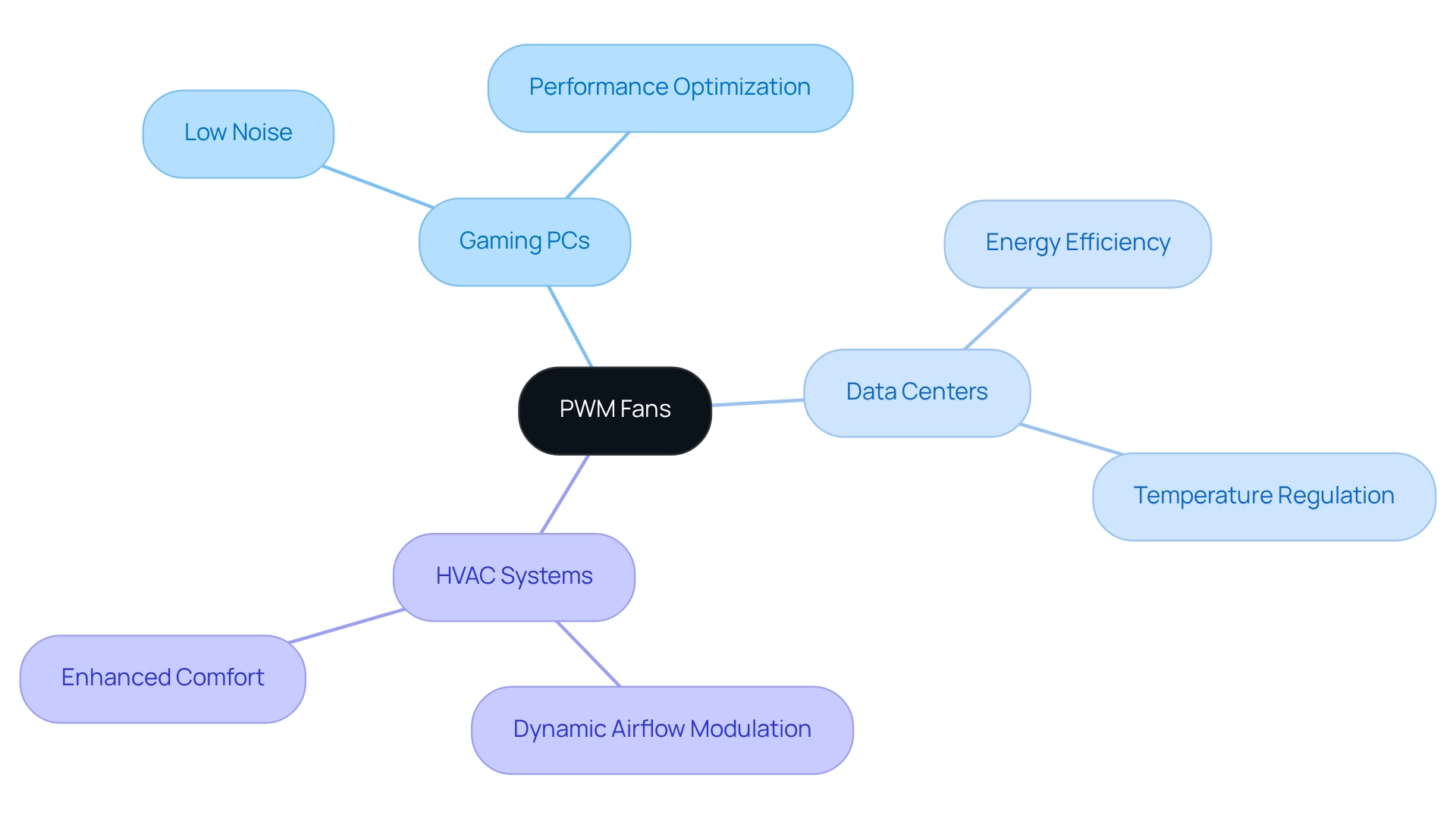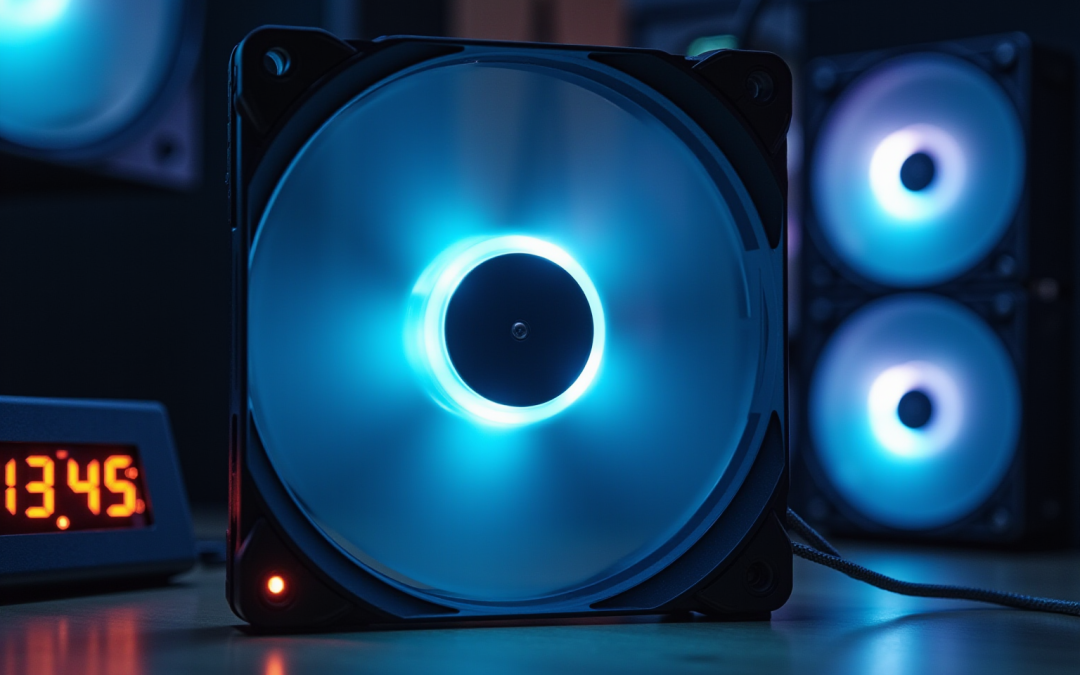Overview
PWM, or Pulse Width Modulation, represents a pivotal technology that empowers fans to dynamically adjust their speed in response to real-time temperature demands. This capability not only enhances energy efficiency but also significantly reduces noise levels.
By illustrating the operational superiority of PWM fans over traditional DC fans, the article delineates their role in providing critical temperature regulation in environments such as data centers and gaming PCs. This advancement ultimately culminates in substantial energy savings and enhanced performance, making PWM technology an essential consideration for modern cooling solutions.
Introduction
In the realm of electronic cooling solutions, Pulse Width Modulation (PWM) emerges as a transformative technology that significantly enhances the efficiency and effectiveness of fan systems. By intelligently adjusting fan speeds in response to real-time thermal demands, PWM optimizes cooling performance while reducing energy consumption and noise levels.
As industries increasingly prioritize energy efficiency and performance, the adoption of PWM technology is poised to revolutionize applications, spanning from data centers to gaming PCs. This article delves into the intricacies of PWM, exploring its operation, benefits, and real-world applications, while underscoring its critical role in modern electronic design and thermal management solutions.
Define PWM: Understanding Pulse Width Modulation
Pulse Width Modulation (PWM) serves as a pivotal method for regulating the operation of electronic devices, particularly ventilators, by modulating the width of the pulses in a signal. In PWM, a digital signal is swiftly toggled on and off, with the duration of the ‘on’ time relative to the ‘off’ time—termed the duty cycle—determining the average power delivered to the device. This technique enables precise fan speed regulation, which illustrates what does PWM mean for fans by allowing for dynamic adjustments in response to the system’s thermal demands.
As a leading provider of , Gagner-Toomey Associates presents an extensive range of DC input tube axial fans and centrifugal blowers, meticulously optimized for performance and efficiency. The integration of PWM technology within the electronics industry is witnessing significant growth, propelled by the rising demand for energy-efficient solutions, particularly in the realm of renewable energy applications. The increasing adoption of renewable energy sources is poised to further stimulate demand for PWM controllers in this sector. By 2025, the market for PWM controllers is anticipated to experience substantial expansion, mirroring a broader trend towards enhancing power management in electronic devices.
PWM finds widespread application across various domains, including computer temperature management systems, where effective temperature regulation is paramount. Gagner-Toomey Associates’ comprehensive portfolio of thermal management solutions, which encompasses both custom and standard temperature regulation options, highlights the critical role of PWM in managing heat within operational systems. A detailed guide titled “Comprehensive Guide to Thermal Solutions for Businesses” underscores the importance of PWM in the selection of suitable thermal solutions. As the industry progresses, recent advancements in PWM technology continue to bolster its efficacy in fan control, prompting inquiries about what does PWM mean for fans in contemporary electronic design. Furthermore, the report comprises a total of 286 pages and 330 tables and figures, emphasizing the depth of research conducted in this field. As articulated by a prominent player in the defense industry, “We were very pleased to contact as they tailored reports precisely as per our requirements,” underscoring the necessity for high accuracy and substantial quality in discussions surrounding PWM technology.
Contextualize PWM in Fan Technology: Importance and Applications
Understanding what does PWM mean for fans is critical as PWM technology, or , facilitates effective temperature regulation in fan systems by dynamically adjusting fan speeds according to the thermal demands of the system. Unlike traditional fans that operate at a constant rate, PWM fans can modify their pace in real-time based on temperature readings, prompting the inquiry of what does PWM mean for fans. This adaptability not only enhances temperature management efficiency but also minimizes noise levels, making it particularly beneficial in environments such as data centers, gaming computers, and industrial applications where optimal thermal regulation is vital for performance and longevity, leading to the question of what does PWM mean for fans, as the dynamic adjustment of fan speeds is instrumental in energy conservation.
According to the Lawrence Berkeley National Laboratory, adopting PWM technology, specifically in the context of what does PWM mean for fans, can yield an approximate 20% reduction in overall energy consumption. This efficiency is exemplified by ACDCFAN’s cutting-edge PWM temperature regulation solutions, which clarify what does PWM mean for fans by functioning quietly at lower speeds without compromising performance. Their products, featuring robust brushless motor designs and IP68 protection, are ideal for a variety of electronic devices, including operating system coolers for laptops and industrial DC chillers, showcasing the versatility and reliability of PWM systems.
In practical scenarios, PWM units are increasingly utilized in data centers and gaming PCs, where maintaining optimal thermal conditions is essential. By effectively regulating airflow and temperature, these devices not only enhance system performance but also extend the lifespan of critical components. Furthermore, engineers must consider what does PWM mean for fans and specific temperature management requirements when choosing between PWM and DC devices, as both options present advantages depending on the particular application. As the demand for energy-efficient cooling solutions continues to escalate, it is important to understand what does PWM mean for fans in fan systems, which remains paramount in 2025 and beyond.
Explore Characteristics of PWM Fans: Operation and Benefits
PWM motors are identifiable by their four-pin connector, which includes a dedicated PWM signal wire that interfaces with the motherboard or controller. This configuration enables precise velocity adjustment, allowing the device to operate effectively at lower speeds without the risk of stalling—a common drawback of .
The advantages of PWM devices are significant:
- They consume less energy
- They produce lower noise levels
- They enhance thermal regulation
By dynamically modulating the speed of the blower based on real-time temperature readings, PWM devices optimize airflow while minimizing energy waste. This feature is particularly advantageous in settings where noise reduction is essential, such as home theaters or office environments.
For example, ACDC’s PWM cooling units, as illustrated in the case study ‘ACDC’s Innovative Cooling Solutions,’ are engineered to deliver efficient cooling while ensuring quiet operation, making them ideal for both residential and industrial applications.
Research from Lawrence Berkeley National Laboratory indicates that data centers can achieve an approximate 20% reduction in total energy consumption by transitioning from to PWM mode, emphasizing the efficiency of this technology.
As Scharon Harding noted, understanding what does PWM mean for fans is crucial for optimizing performance across various applications. Overall, the features and benefits of PWM devices position them as a superior choice compared to conventional DC units in a range of applications.

Illustrate Examples of PWM Fans: Real-World Applications and Comparisons
In a variety of applications, including personal computers and industrial machinery, one might wonder [what does PWM mean for fans](https://gagner-toomey.com/what-is-pwm-mode-for-fans-understanding-functionality-and-benefits). In the realm of gaming PCs, what does PWM mean for fans is crucial as they are favored for their capacity to sustain low noise levels while providing effective cooling during intense gaming sessions. This aspect is particularly vital, as gamers demand optimal performance without disruptive sound.
As noted by Arctic, “In fact, we discovered it to be just slightly louder at 1200 rpm than while providing similar airflow,” which underscores the efficacy of PWM devices in harmonizing noise and performance.
In data centers, PWM devices serve a pivotal role in temperature regulation, ensuring servers function within safe limits and bolstering overall energy efficiency. Unlike conventional DC devices that typically operate at maximum capacity without regard for cooling needs, PWM units adjust their operation based on real-time temperature measurements. This capability not only curtails unnecessary noise but also reduces energy consumption, which is essential for understanding what does PWM mean for fans, rendering them a more sustainable option.
Additionally, while certain DC fan models accommodate voltage-regulated speeds, they lack the flexibility and efficiency that understanding what does PWM mean for fans techniques can provide. PWM devices are increasingly employed in HVAC systems, where they dynamically modulate airflow to optimize energy savings and enhance comfort in both residential and commercial settings.
For instance, the Thermaltake Toughfan 12 Turbo, specifically designed for radiators, exemplifies how [PWM technology can effectively push air through dense mesh](https://pcgamer.com/best-pc-fans), establishing it as a premier choice for high-density environments. This adaptability and efficiency highlight what does PWM mean for fans in various sectors.

Conclusion
The exploration of Pulse Width Modulation (PWM) technology highlights its transformative impact on electronic cooling solutions, particularly within fan systems. By enabling precise control over fan speeds in response to real-time thermal demands, PWM not only enhances cooling performance but also significantly reduces energy consumption and noise levels. The versatility of PWM fans is evident across diverse applications, from gaming PCs to industrial machinery, where maintaining optimal thermal conditions is essential for performance and longevity.
The advantages of PWM technology extend beyond mere efficiency; they encompass reduced noise levels, lower power consumption, and improved thermal management. This makes PWM fans a superior choice over traditional DC fans, especially in environments where silence and energy conservation are paramount. As industries increasingly prioritize sustainable practices, the shift towards PWM technology in cooling solutions represents not just a trend but a necessary evolution in electronic design.
As the market for PWM controllers continues to expand, driven by the demand for energy-efficient solutions, the critical role of PWM in modern thermal management becomes ever more apparent. Embracing PWM technology is essential for optimizing performance across diverse sectors, ensuring that systems operate effectively while minimizing their environmental impact. The future of electronic cooling will undoubtedly be shaped by advancements in PWM technology, establishing it as a cornerstone of efficient and sustainable design.
Frequently Asked Questions
What is Pulse Width Modulation (PWM)?
Pulse Width Modulation (PWM) is a method for regulating the operation of electronic devices by modulating the width of the pulses in a digital signal, which controls the average power delivered to the device.
How does PWM work in regulating devices like fans?
In PWM, a digital signal is toggled on and off quickly, with the duration of the ‘on’ time relative to the ‘off’ time—known as the duty cycle—determining the average power. This allows for precise fan speed regulation and dynamic adjustments based on thermal demands.
What are the benefits of using PWM in electronic devices?
PWM enables energy-efficient solutions, enhances power management, and allows for effective temperature regulation in devices, which is particularly important in applications like computer temperature management systems.
What is the significance of PWM technology in the context of renewable energy?
The integration of PWM technology is growing due to the rising demand for energy-efficient solutions in renewable energy applications, which is expected to stimulate demand for PWM controllers in the sector.
How is Gagner-Toomey Associates involved with PWM technology?
Gagner-Toomey Associates offers a range of DC input tube axial fans and centrifugal blowers optimized for performance and efficiency, utilizing PWM technology for effective thermal management solutions.
What does the future look like for the PWM controller market?
The market for PWM controllers is anticipated to experience substantial growth by 2025, reflecting a broader trend towards enhancing power management in electronic devices.
What resources are available for understanding PWM and its applications?
A detailed guide titled ‘Comprehensive Guide to Thermal Solutions for Businesses’ highlights the importance of PWM in selecting suitable thermal solutions and includes extensive research with 286 pages and 330 tables and figures.

